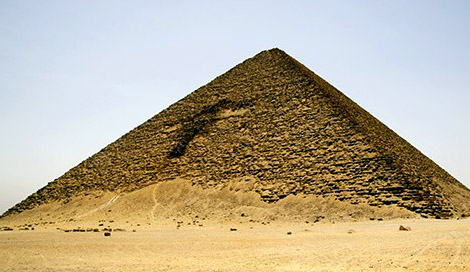After simple structures in archaic era, in the Old Kingdom Egyptians started to buried pharaos in the pyramids, while other dignitaries (and less ambitious pharaohs) used mastaba.
Mastabas are tombs that have long square shape built in two levels. The above ground level contains the mortal temple, while the underground part is actually a burial chamber, in which it was able to enter through a vertical shaft that was closed by a wall.
Pyramids are geometrical bodies used to build the pharaoh tombs of the Old Kingdom. Historians believed that the shape was created by extending the obelisk, a shape through which they wanted to show a divine power and material perfection.
Initially, an obelisk served as a symbol of the Sun’s cult and it represented descending of the Sun’s rays on the earth. It is believed that the construction of the pyramids had greater meaning than a mere tombs for the rulers; perhaps a certain mythological and historical obligation of the Pharaoh was that with these “ideal” form shows the perfection of the order; as well as divine and material.
The period when a construction of the pyramids took place is largely unknown to historians, so it is difficult to determine with certainty the exact motives of construction of these facilities; also, it is unknown the reason why construction of pyramids was stopped.
The complex of the one pyramid was consisted of so-called “temple in the valley”, which was usually a symbolic port on the Nile, followed by a fenced stone path and shrines along the pyramid itself. Today those places are called funerary temples.
In those shrines were serdabi; rooms without windows and doors with two holes through which the Pharaoh statues could watch the world.



The construction of the pyramid continues in the Fifth and Sixth Dynasty, but it does not follow complexity or intensity of the pyramids in Third and Fourth Dynasty. Something new that can be seen in later pyramids (5. and 6.) was religious text written on the walls of the pyramids. Something interrupted a construction of the pyramidsin the first transition period, but it has been started in the Middle period for short time, and after that, it has been stopped forever.
Great Sphinx in Giza was discoveredin front of Khafre’e’s funeral temple. It was made from a single piece of rock, and it shows the Egyptian God Harmakhis (Horemakhet – “Horus on the horizon”). The pharaohs of the Fourth Dynasty built it, but it is not showing Pharaoh Khafre; it is older than the pyramid of Khafre itself.
An art is static and two-dimensional, and is used primarily for the purposes of the funeral cult of the dead. The static is necessary in order to display the hibernation of the movement in the eternity; while the two-dimensionality and strange depictions of people and animals (in the painting) are used in order to, each displayed object “secure” life so that in each object only important parts were shown. A display of a man as an example: it has to be visible both arms, both legs, head in profile in order to be able to see the nose and ear, then eye en face because in profile it is not very visible, also both sides of the chest and belly button as well as hips and feet.
In statuary, there is domination of the volume; cubic shape ensures stability of the sculpture (it will take longer if there were no parts that are separated, for example, when it comes to hands of the antique sculptures whose hands were usually broken). One of the most famous groups from that period was painted representation of the prince Rahotep and his wife Nofret.
